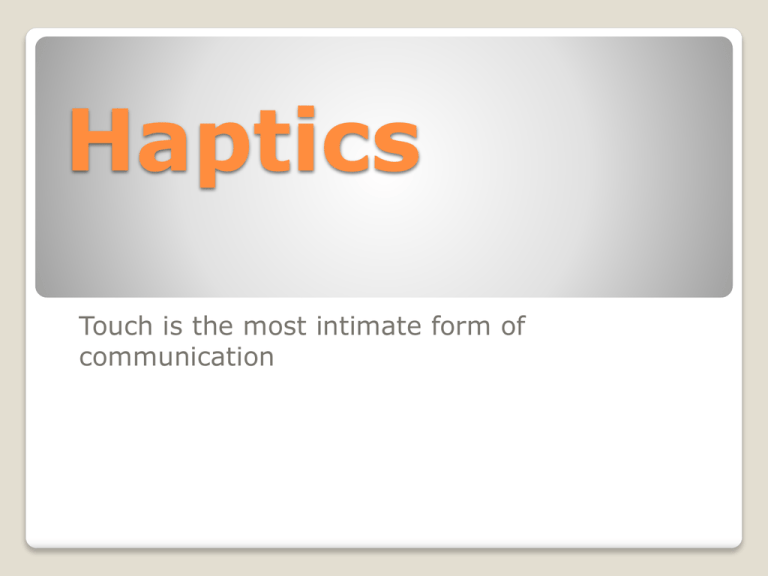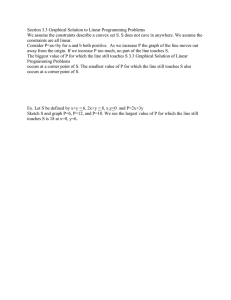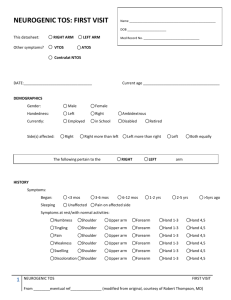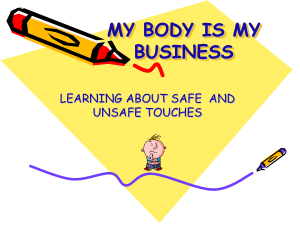Haptics
advertisement

Haptics Touch is the most intimate form of communication Metaphors associated with touch keeping in touch. not being in touch with reality. a touching gesture. using the “soft touch” on someone the importance of touch “Touch has the power to repel, disgust, insult, threaten, console, reassure, love, and arouse” (Andersen, 2008) brush caress clinch cuddle embrace grope handshake high five hit hold hug feel fondle kiss knuckle bump nibble pat pinch poke prod push reach around rub scratch shove slap spank squeeze stroke tickle functions of touch Greeting rituals Comfort, reassurance Positive or negative affect Communicating status, power Conveying the level of intimacy touch in infancy Touch is the first sense humans develop. Touch is essential for proper emotional and psychological development. Monkeys raised in isolation from their mothers were maladjusted (Harlow, 1958) Preemies who are touched grow faster. In orphanages, untouched children die of merasmus (wasting away) (Montagu, 1978) Tactile stimulation in the first years of live is necessary for brain development (Gerhart, 2004; Perry, 2002) context is key The communication context determines the meaning of touch. ◦ pat on the back reassuring or condescending? ◦ punch in the arm Playful or aggressive? ◦ slap on the butt in sports Okay on the field, not okay in the locker room. Culture shapes the meaning assigned to touch ◦ two males holding hands ◦ shaking hands with the left hand ◦ a male shaking a woman’s hand Who touches whom? In public places, males initiate more touch than females (Hertenstein, Verkemp, et al., 2006) In private settings, women initiate touch more often (Major et al., 1990) Women use more nonhand touches than men (body and leg touches). Men are more likely to initiate touch early in a relationship Women are more likely to initiate touch in marriages More about who touches whom Overweight people ◦ receive fewer touches (Holmes, 2005) People with disabilities ◦ Touching a person’s wheelchair or other assistive device is inappropriate. Touch avoiders ◦ Some people are apprehensive about touching and being touched Touch illiterates ◦ Some people lack awareness of social norms governing touch Appropriate or inappropriate? Male Touchers ◦ ◦ ◦ ◦ ◦ male friend boss father teacher uncle Female Touchers ◦ ◦ ◦ ◦ ◦ female friend boss mother teacher aunt Female Touchees ◦ ◦ ◦ ◦ ◦ arm shoulder forearm knee face ◦ ◦ ◦ ◦ ◦ arm shoulder forearm knee face Male Touchees The handshake shake it, don’t break it types of handshakes the dead fish the bone crusher lady fingers the swoop in the stiff arm the two-hander the pump handle the saw Alternatives ◦ ◦ ◦ ◦ high five knuckle bump double-handed cheek kiss The “correct” Western handshake Avoid sweaty palms (handkerchief) Stand up, walk around objects Look at the person, not at their hand Make eye contact, smile Save the doubleDon’t shake with your left hand hander for the U.N. Offer a firm shake, not overpowering Use full palm to palm contact Make full palm-to-palm contact Remember the person’s name Are you rescuing a Avoid vice grips princess or shaking hands? No thumbwrestling, please Status, power and touch People with higher status tend to touch more than those with low status (Henley, 1973) 88% of handshakes, in one study, were initiated by managers In organizational settings, superiors touch subordinates more than subordinates touch superiors (Remland, 1981). Higher status persons have more touch privilege than low status persons (Andersen, 2008) exerting dominance, control An airline passenger claims the armrest by bumping another passenger’s arm off. A standing manager places both hands on a seated employee’s shoulders while saying, “You’re going to have that report for me by the end of the day, right?” A boyfriend puts his arm around his girlfriend and pulls her in closer to him to signal possessiveness. Touching people’s possessions—grabbing their cell phone or iPod Touch and compliance gaining “Phone booth” study. A confederate intentionally left a coin in a phone booth for another person to find. No touch condition: When the person found the coin, the confederate approached him/her and said “Did you happen to seem my coin in that phone booth? I need it to make another call?” ◦ 23% compliance Touch condition: the confederate touched the person lightly on the elbow for 1-3 seconds and asked if they found the coin. ◦ 68% compliance Cultural differences in replicating the phone booth study: Touch was most effective in low-touch cultures: 22% compliance for Italians 50% compliance for French 72% compliance for Australians 70% compliance for English 85% compliance for Germans Touch and compliance gaining Food servers and compliance gaining Retail sales Bystanders and helping behavior Incidental touch in a library Touch and requests for donations Guidelines make the touch light and brief ◦ A count of “one Mississippi.” look for signs of discomfort ◦ moving farther away, crossing arms, buttoning coat limit contact to the shoulder, forearm, elbow, or back. Don’t touch bare shoulders or backs











